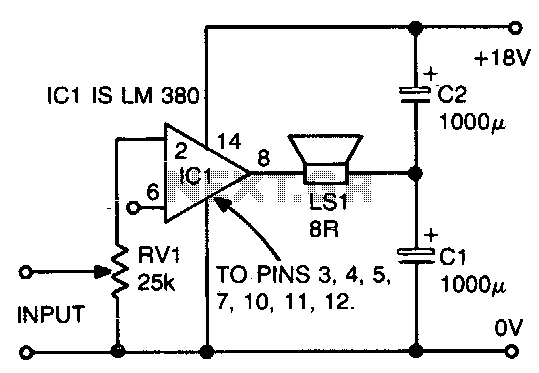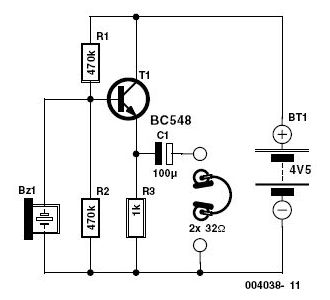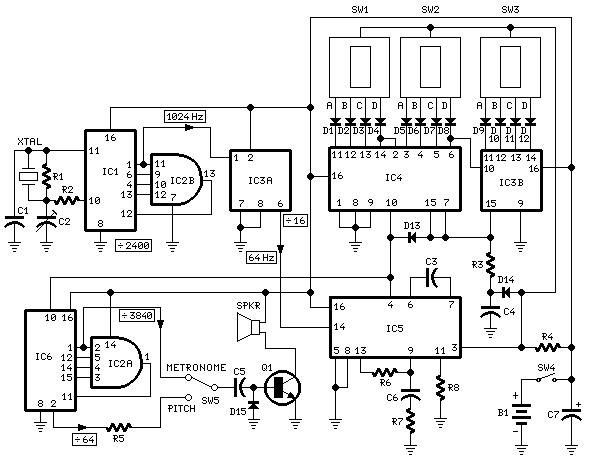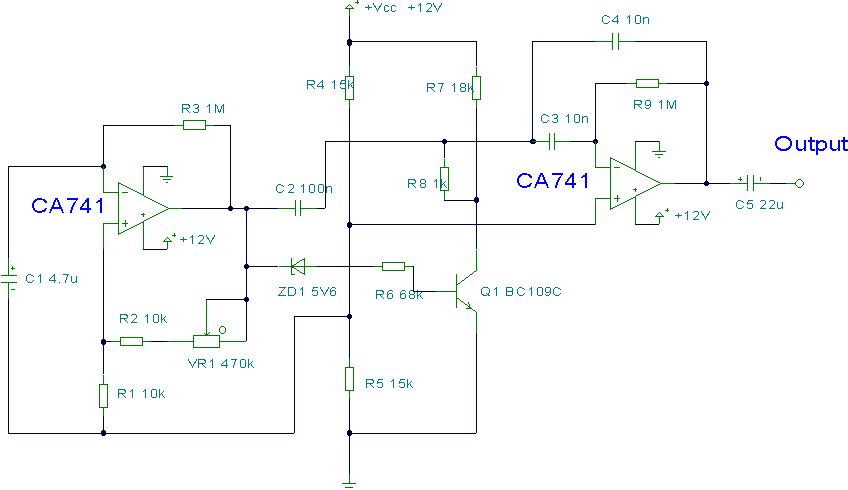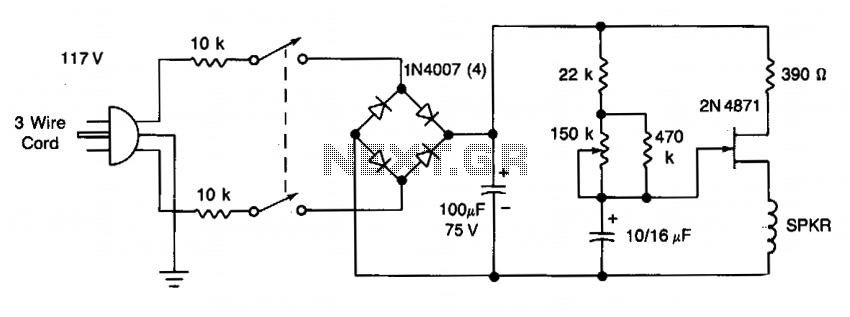
Novel Metronome
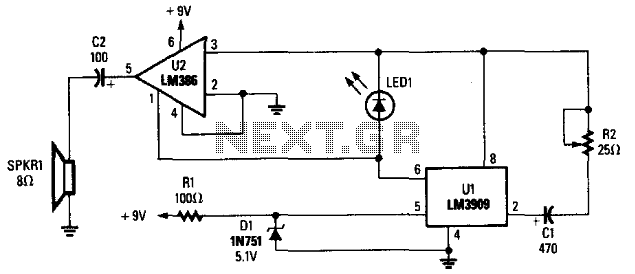
The LM3909 is configured such that the frequency of oscillation relies on a single RC timing circuit, which includes capacitor C1 and resistor R2. LED1 discharges capacitor C1, and the resulting pulse is directed to both pin 3 and pin 1 of the LM386 audio amplifier to control that unit externally, thus ensuring sufficient volume. The circuit, in its current configuration, provides frequency ranges from 57 to 204 beats per minute, along with ample volume.
The LM3909 integrated circuit is designed for applications requiring a flashing LED or sound output, commonly utilized in visual and auditory alert systems. The core of its operation is an oscillator, which generates a frequency based on the RC timing circuit formed by capacitor C1 and resistor R2. The values of these components determine the oscillation frequency, allowing for adjustments to achieve a desired beat rate.
When the circuit is powered, capacitor C1 charges through resistor R2 until it reaches a threshold voltage, at which point it discharges rapidly through LED1. This discharge creates a pulse that not only illuminates the LED but also sends a signal to the LM386 audio amplifier. The LM386 is a low-voltage audio power amplifier capable of delivering significant output power, making it suitable for driving speakers or providing audio alerts.
The connection of the pulse to pins 3 and 1 of the LM386 ensures that the audio output is modulated in sync with the oscillation frequency of the LM3909. This configuration allows for the generation of audio tones that correspond to the visual flashing of the LED, creating a cohesive alert signal. The frequency range of 57 to 204 beats per minute is particularly useful for applications such as timers, alarms, and other signaling devices, providing both auditory and visual cues to the user.
In summary, the LM3909 circuit, through its innovative use of the RC timing components and the integration with the LM386 audio amplifier, offers a versatile solution for generating synchronized visual and audio signals across a wide frequency range, suitable for various electronic applications. The LM3909 is configured so that the frequency of oscillation is dependent on a single RC timing circuit, which consists of CI and R2. LED1 discharges capacitor CI and the resultant pulse is directed into pin 3 as well as pin 1 of the LM386 audio amplifier to externally control that unit, thereby providing adequate volume. The circuit, as it is configured, provides frequency ranges from 57 to 204 beats per minute, and plenty of volume.
🔗 External reference
The LM3909 integrated circuit is designed for applications requiring a flashing LED or sound output, commonly utilized in visual and auditory alert systems. The core of its operation is an oscillator, which generates a frequency based on the RC timing circuit formed by capacitor C1 and resistor R2. The values of these components determine the oscillation frequency, allowing for adjustments to achieve a desired beat rate.
When the circuit is powered, capacitor C1 charges through resistor R2 until it reaches a threshold voltage, at which point it discharges rapidly through LED1. This discharge creates a pulse that not only illuminates the LED but also sends a signal to the LM386 audio amplifier. The LM386 is a low-voltage audio power amplifier capable of delivering significant output power, making it suitable for driving speakers or providing audio alerts.
The connection of the pulse to pins 3 and 1 of the LM386 ensures that the audio output is modulated in sync with the oscillation frequency of the LM3909. This configuration allows for the generation of audio tones that correspond to the visual flashing of the LED, creating a cohesive alert signal. The frequency range of 57 to 204 beats per minute is particularly useful for applications such as timers, alarms, and other signaling devices, providing both auditory and visual cues to the user.
In summary, the LM3909 circuit, through its innovative use of the RC timing components and the integration with the LM386 audio amplifier, offers a versatile solution for generating synchronized visual and audio signals across a wide frequency range, suitable for various electronic applications. The LM3909 is configured so that the frequency of oscillation is dependent on a single RC timing circuit, which consists of CI and R2. LED1 discharges capacitor CI and the resultant pulse is directed into pin 3 as well as pin 1 of the LM386 audio amplifier to externally control that unit, thereby providing adequate volume. The circuit, as it is configured, provides frequency ranges from 57 to 204 beats per minute, and plenty of volume.
🔗 External reference
